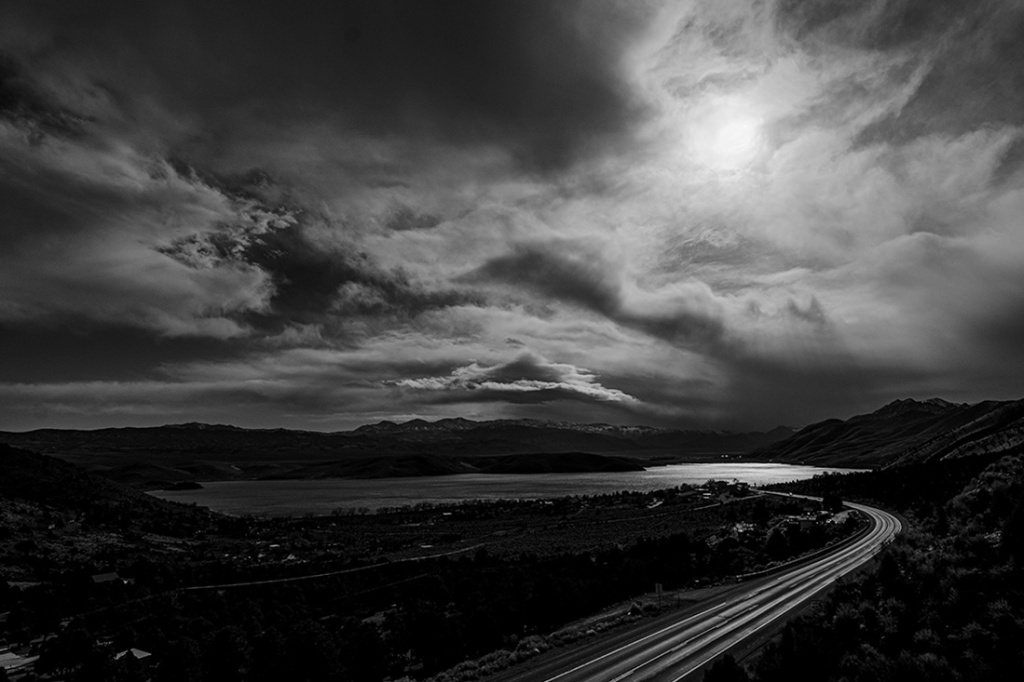Is less a lack of light
Than a quality of seeing
Topaz Lake
Nevada/California, United States of AmericaTaken during travels, 2019
A camera sensor isn’t nearly as good as our eye at “seeing” the full range of light in most lighting conditions. Bright, sunny days are especially prone to having a high dynamic range — very, very bright highlights (like clouds backlit by the sun) and very, very dark shadows (like the shade under a very large and thickly-leaved tree). HDR software combines those five photographs very intelligently. The underexposed photographs have the details in the scene’s highlights. The overexposed photographs have the details in the scene’s shadows. The exposures in the middle have the best detail in the mid-tones. The output of the HDR program is an image with very fine detail across the entire photograph, from the brightest highlights to the deepest shadows.

The result is an image my camera could never capture with a single photographic exposure, but it’s also a result which is much closer to the way I saw the scene with my own eyes when I photographed it.However, after creating the HDR interpretation of the scene, I noticed that the most underexposed photograph had some interesting qualities as well, so I worked with it to come up with the featured image above, “Day for Night”.
We like to think of photographs as visual documents of reality, but, really, every photograph is an interpretation of reality during the time(s) the shutter was open. Sometimes, that interpretation is entirely illusory; despite all the lighting cues your mind perceives in “Day for Night”, that’s not a moon in the sky, but the sun. On the other hand, it took a lot more effort and computer power to make the bracketed photographs I’d taken produce an image which approximates what my eye had actually seen that day.
Or, as the poem puts it, sometimes it takes a lot of work to reveal the illusion and see the true light.
Pic and a Word Challenge
Last week we got large with Expanse. This week, let’s see through the Illusions, or find something else to inspire you in this day for night photograph of Topaz Lake along US HWY 395, which straddles the state border between Nevada and California, USA.
The Pic and a Word Challenge is a weekly creativity prompt offered Sundays.
Each week I provide a photograph of mine along with a single word. The challenge? Use the pic and/or word as points of inspiration to create something — a photograph, a painting, prose, poetry, fiction, non-fiction, longread or just a few words. You are welcome to use these two elements (photograph and word) literally, thematically or metaphorically. If you create both images and words, all the better.
To participate:
- Use any title you like
- Your response can be words and/or images
- You may use my image in your post, or any image you have created
- Mention that you are responding to the Pic and a Word Challenge
- Add a link to this post in your response
To help us find your response — whether on WordPress, Instagram, Flicker, Tumblr, etc. — you can also:
- Add a comment on this post to announce your response
- Apply the tag/hashtag “Pic and a Word Challenge” or “#picandawordchallenge” to your post
Each week, I’ll list the previous week’s responses at the end of the new challenge. I may also share some on my social media: Facebook, Twitter, Pinterest, Tumblr, etc.

The word for last week’s Pic and a Word Challenge #212 was Expanse, along with this photograph of the expansive landscape along California’s US HWY 395 at Willow Ranch, United States of America.So far, two bloggers crossed the Expanse this week. (My, how the holidays have gone by in a blur!) =) Thank you, everyone! ❤
View all the Pic and a Word Challenges, including the current challenge, on the Pic and a Word Challenge tag page.
Happy Creating!
